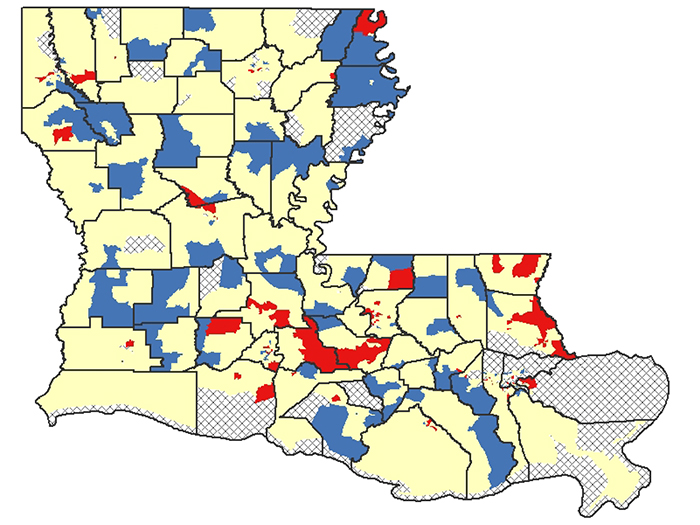LSUHealthNO LA Tumor Registry Releases 2nd Census Tract Cancer Incidence Report

The release of cancer incidence data is governed by the federal patient privacy law and federal standards for producing valid data. To protect patient confidentiality, HIPAA prohibits publication of health information by geographic area when the underlying population is 20,000 or less. The United States Cancer Statistics standards for generating reliable cancer incidence rates require case counts of 16 or more to report. To increase the number of census tracts meeting the publication criteria, LTR combined 11 years of data – 2005-2015.
Cancer incidence rate is the number of newly diagnosed cancer cases in a specified population during the specified years, usually expressed as the number of cancers per 100,000 population.Census tracts are small, relatively permanent statistical subdivisions of a parish. Census tracts generally have a population size between 1,200 and 8,000 people. Of the 1,148 census tracts in Louisiana, 943 met the publication criteria for all cancers combined. For specific cancer types, fewer census tracts met the criteria.
For all cancers combined, of the 943 census tracts meeting the publication criteria when 2005-2015 data were combined, 84 census tracts from 29 parishes had statistically significantly higher incidence rates as compared with Louisiana, and 108 census tracts had lower incidence rates.Results for the most common specific cancer types include:
![]()
![]()
![]()
![]()
Prostate Cancer: Of the 501 census tracts meeting the publication criteria, 41 census tracts in 18 parishes had statistically significantly higher incidence rates than Louisiana, and 43 had lower rates.
Female Breast Cancer: Of the 553 census tracts meeting the publication criteria, 21 census tracts in 14 parishes had statistically significantly higher incidence rates than Louisiana, and 38 census tracts had lower rates.Colorectal Cancer: Of 737 census tracts meeting the publication criteria, 51 census tracts in 29 parishes had statistically significantly higher incidence rates than Louisiana, and 28 census tracts had lower rates.
Cancers of the Kidney and Renal Pelvis: Of 172 census tracts meeting the publication criteria, 20 census tracts in 15 parishes had statistically significantly higher incidence rates than Louisiana, and none had lower rates.![]()
![]()
![]()
![]()
![]()
![]()
![]()
Urinary Bladder Cancer: Of 119 census tracts meeting the publication criteria, 19 census tracts in 14 parishes had statistically significantly higher incidence rates than Louisiana, and none had lower rates.
Melanoma of the Skin: Of 115 census tracts meeting the publication criteria, 67 census tracts in 17 parishes had statistically significantly higher incidence rates than Louisiana, and none had lower rates.Pancreas: Of 16 census tracts meeting the publication criteria, 5 census tracts in 3 parishes had statistically significantly higher incidence rates than Louisiana, and none had lower rates.
Oral Cavity & Pharynx: Of 28 census tracts meeting the publication criteria, 9 census tracts in 7 parishes had statistically significantly higher incidence rates than Louisiana, and none had lower rates.Leukemia: Of 24 census tracts meeting the publication criteria, 5 census tracts in 5 parishes had statistically significantly higher incidence rates than Louisiana, and none had lower rates.
Thyroid: Of 19 census tracts meeting the publication criteria, 9 census tracts in 5 parishes had statistically significantly higher incidence rates than Louisiana, and none had lower rates.Corpus Uterus: Of 3 census tracts meeting the publication criteria, 2 census tracts in 1 parish had statistically significantly higher incidence rates than Louisiana, and none had lower rates.
Liver and Intrahepatic Bile Duct: Of 2 census tracts meeting the publication criteria, 2 census tracts in 2 parishes had a statistically significantly higher incidence rates than Louisiana, and none had lower rates.Stomach: There is only one census tract meeting the publication criteria and the incidence rate was not statistically significantly higher than Louisiana.

“The cancer incidence information we publish can be used in many ways,” notes Xiao-Cheng Wu, MD, MPH, Professor and Director of the Louisiana Tumor Registry at LSU Health New Orleans School of Public Health. “Providing a clear picture of areas with higher incidence rates for all cancers combined and specific cancer types not only guides cancer reduction policy and special studies by qualified scientists to determine the why behind the statistics, but it can also help educate the citizens of Louisiana about the importance of reducing their exposure to modifiable risk factors, such as tobacco use, obesity, unhealthy diet, physical inactivity, occupational and environmental exposures, and certain pathogens, as well as complying with cancer screening guidelines to minimize their chances of developing cancer.”
LSU Health New Orleans Louisiana Tumor Registry is a statewide population-based cancer registry authorized by law to collect data on all reportable cancer cases occurring among Louisiana residents. A registry serves as an official count of a specific thing and its associated identifying information.A cancer registry systematically collects data on reportable cancers, which includes patient demographics, cancer type, stage at diagnosis, and the first course of treatment, as well as survival. This information is used to answer questions such as: Are more or fewer people getting colorectal cancer from one reporting period to the next?
LTR's job is to collect high-quality cancer data, which guide and support cancer prevention and control activities, as well as many other cancer-related programs and research. Policymakers, state health departments, cancer control programs and other qualified health professionals decide if further action is warranted based on the LTR data.LTR's excellence is attested by the National Cancer Institute (NCI), the Centers for Disease Control and Prevention (CDC), and the North American Association of Central Cancer Registries (NAACCR). LTR consistently achieves the benchmark of 98% case completeness set forth by NCI and has received first place awards for the quality and completeness of its data from NCI’s Surveillance, Epidemiology, and End Results (SEER) program for the past nine consecutive years. One of only 16 cancer registries in the country comprising NCI’s SEER Program, LTR is considered to be one of the leading cancer registries in the nation.
The complete report, with maps, is available online here.